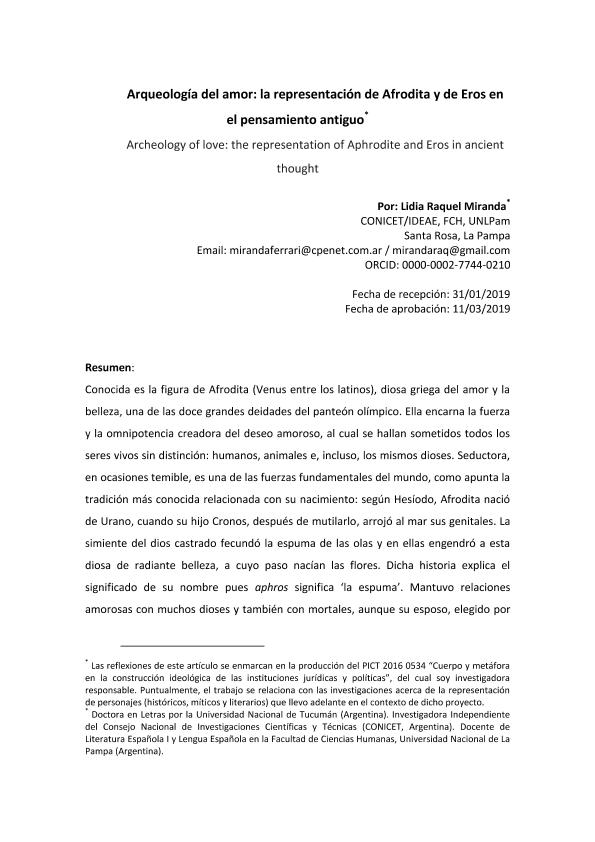Artículo
Conocida es la figura de Afrodita (Venus entre los latinos), diosa griega del amor y la belleza, una de las doce grandes deidades del panteón olímpico. Ella encarna la fuerza y la omnipotencia creadora del deseo amoroso, al cual se hallan sometidos todos los seres vivos sin distinción: humanos, animales e, incluso, los mismos dioses. Seductora, en ocasiones temible, es una de las fuerzas fundamentales del mundo, como apunta la tradición más conocida relacionada con su nacimiento: según Hesíodo, Afrodita nació de Urano, cuando su hijo Cronos, después de mutilarlo, arrojó al mar sus genitales. La simiente del dios castrado fecundó la espuma de las olas y en ellas engendró a esta diosa de radiante belleza, a cuyo paso nacían las flores. Dicha historia explica el significado de su nombre pues aphros significa ‘la espuma’. Mantuvo relaciones amorosas con muchos dioses y también con mortales, aunque su esposo, elegido por Zeus, era Hefestos, el dios del fuego. De sus amores con Ares (el Marte de los romanos), dios de la guerra, nació Eros, el dios del amor. Eros (Cupido entre los romanos), que simboliza el deseo sensual, es el dios griego responsable de la atracción sexual, el amor y el sexo, venerado también como un dios de la fertilidad. Según Hesíodo, es una de las fuerzas primordiales que nace del Caos. Según otras versiones, como señalamos antes, es hijo de Ares y de Afrodita. De acuerdo con el mito que ofrece El banquete de Platón, Eros fue concebido por Poros (el Recurso) y Penía (la Pobreza) en el cumpleaños de Afrodita. A partir de la tradición iniciada por Eratóstenes, Eros rige fundamentalmente el amor entre hombres, mientras que Afrodita lo hace sobre el amor entre hombres y mujeres. En imágenes tardías, se lo representa como un niño travieso, muchas veces con los ojos vendados, equipado con un arco y flechas con las que atraviesa los corazones de los enamorados. En este trabajo nos ocuparemos de rastrear –aunque sin pretensión de exhaustividad– las figuras de Afrodita y de Eros en los episodios míticos más conocidos o relevantes de la literatura clásica, en atención a dos líneas principales de interpretación de ambos dioses: las referidas al discurso amoroso y/o erótico que surge en torno a ellos y sus acciones y las vinculadas con el cuerpo y sus características. Known is the figure of Aphrodite (Venus among Latins), Greek goddess of love and beauty, one of the twelve great deities of the Olympic pantheon. She embodies the force and creative omnipotence of loving desire, to which all living beings are subject without distinction: humans, animals and even the gods themselves. Seductive, sometimes fearsome, is one of the fundamental forces of the world, as pointed out by the best-known tradition related to his birth: according to Hesiod, Aphrodite was born of Uranus, when his son Cronos, after mutilating him, threw his genitals into the sea. The seed of the castrated god fecundated the foam of the waves and in them engendered this goddess of radiant beauty, at whose passage the flowers were born. This story explains the meaning of his name because aphros means 'foam'. He maintained loving relationships with many gods, and also with mortals, although her husband, chosen by Zeus, was Hephaestus, the god of fire. From his love affair with Ares (the Mars of the Romans), god of war, was born Eros, the god of love. Eros (Cupid among the Romans), which symbolizes sensual desire, is the Greek god responsible for sexual attraction, love and sex, also revered as a god of fertility. According to Hesiod, it is one of the primordial forces born of Chaos. According to other versions, as we pointed out before, he is the son of Ares and Aphrodite. According to the myth that Plato's Banquet offers, Eros was conceived by Poros (the Resource) and Penía (Poverty) on the birthday of Aphrodite. Starting from the tradition initiated by Eratosthenes, Eros fundamentally governs love between men, while Aphrodite does it over love between men and women. In later images, he is shown as a mischievous child, often blindfolded, equipped with a bow and arrows that pierces the hearts of lovers. In this paper, we will investigate, although without pretension of exhaustiveness, the figures of Aphrodite and Eros in the most known or relevant mythical episodes of classical literature, in attention to two main lines of interpretation of both gods: those referring to speech amorous and / or erotic that arises around them and their actions and those related to the body and its characteristics.
Arqueología del amor: la representación de Afrodita y de Eros en el pensamiento antiguo
Título:
Archeology of love: the representation of Aphrodite and Eros in ancient thought
Fecha de publicación:
06/2019
Editorial:
Universidad Nacional del Nordeste. Facultad de Humanidades. Instituto de Filosofía
Revista:
Nuevo Itinerario
ISSN:
1850-3578
Idioma:
Español
Tipo de recurso:
Artículo publicado
Clasificación temática:
Resumen
Palabras clave:
AMOR
,
AFRODITA
,
EROS
,
ANTIGUEDAD
Archivos asociados
Licencia
Identificadores
Colecciones
Articulos(CCT - PATAGONIA CONFLUENCIA)
Articulos de CTRO.CIENTIFICO TECNOL.CONICET - PATAGONIA CONFLUENCIA
Articulos de CTRO.CIENTIFICO TECNOL.CONICET - PATAGONIA CONFLUENCIA
Citación
Miranda, Lidia Raquel; Arqueología del amor: la representación de Afrodita y de Eros en el pensamiento antiguo; Universidad Nacional del Nordeste. Facultad de Humanidades. Instituto de Filosofía; Nuevo Itinerario; 14; 6-2019; 30-57
Compartir
Altmétricas




